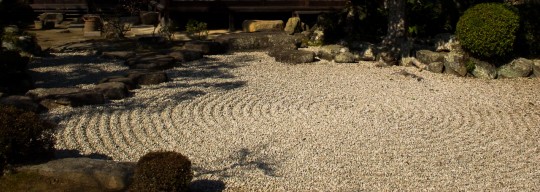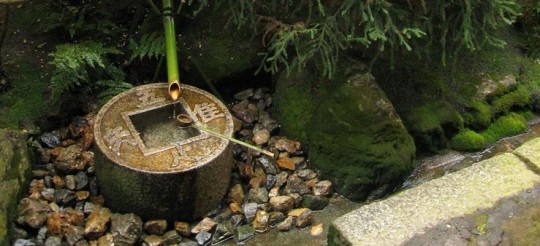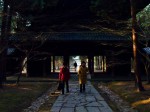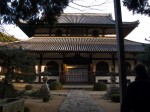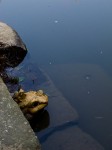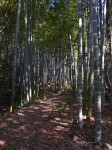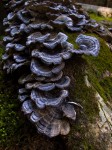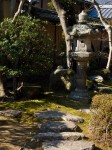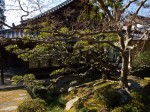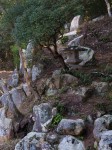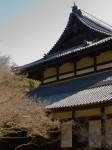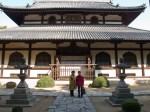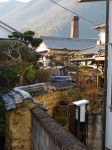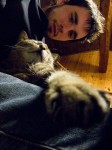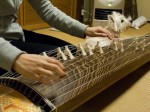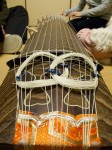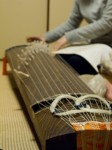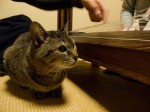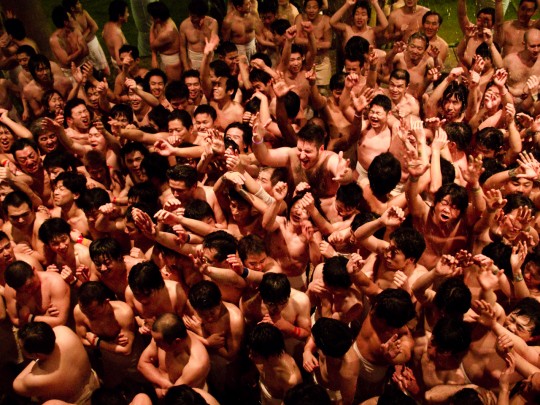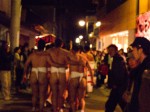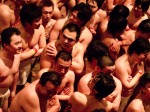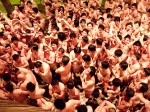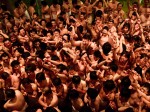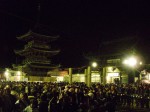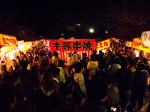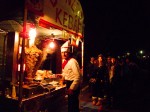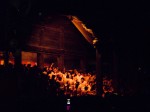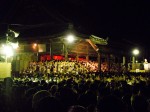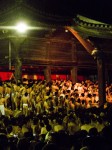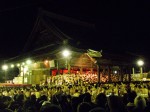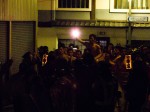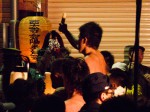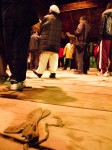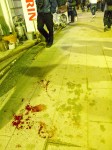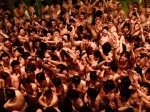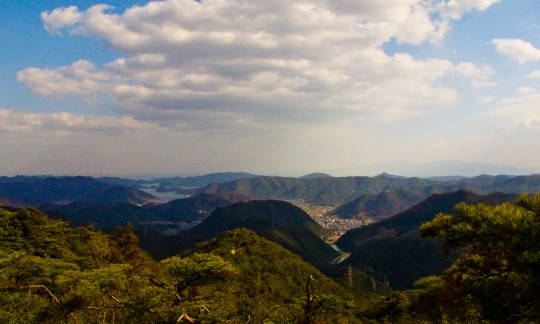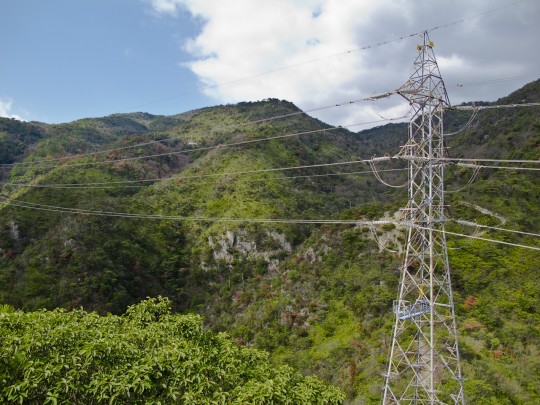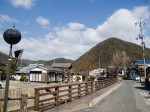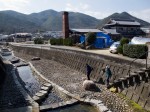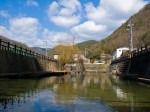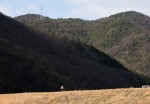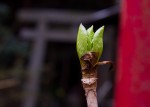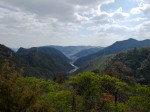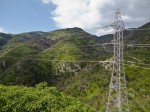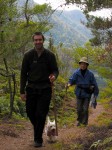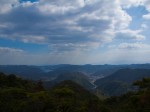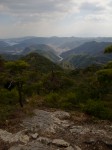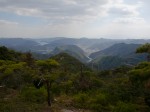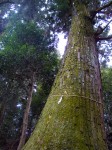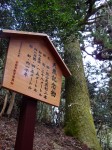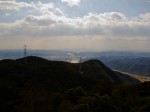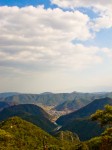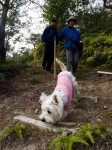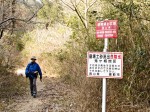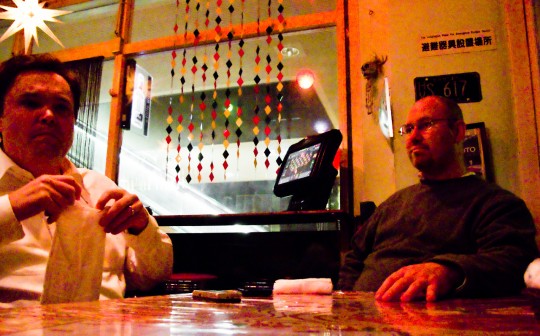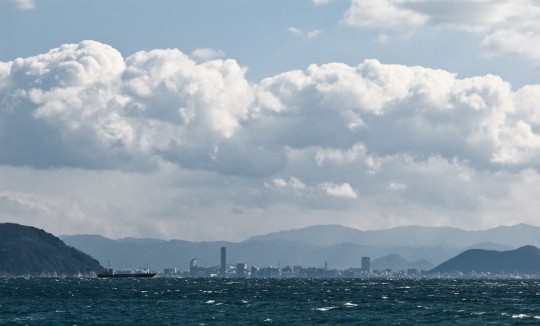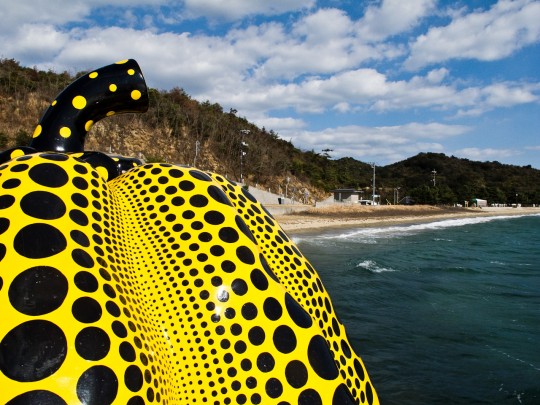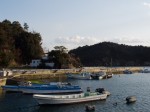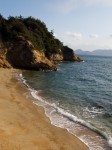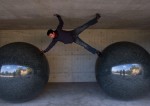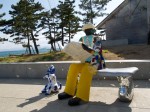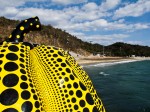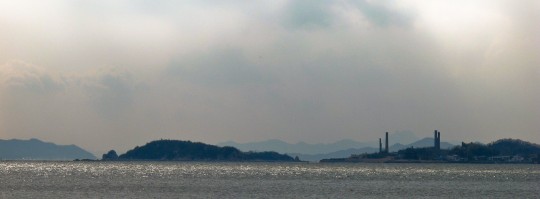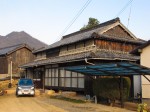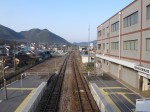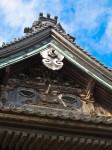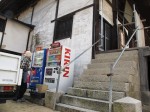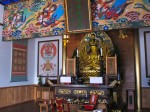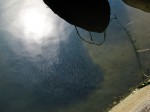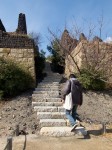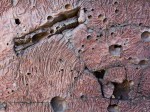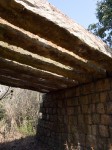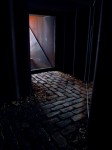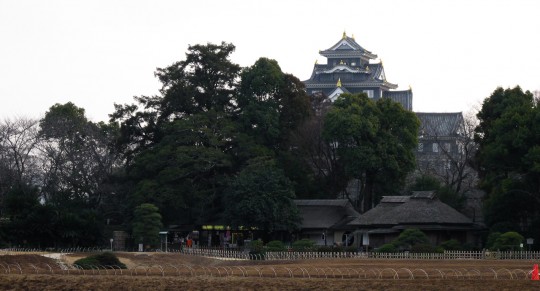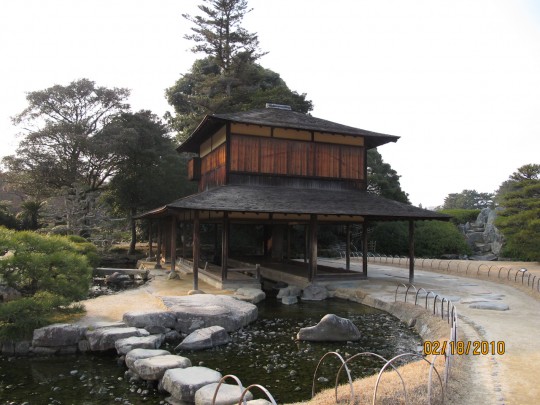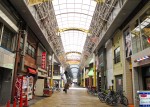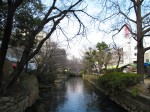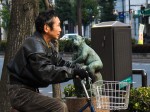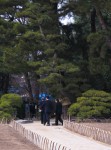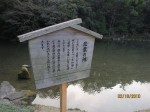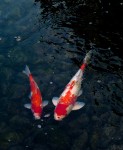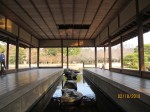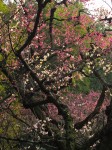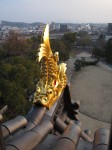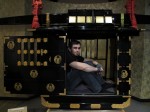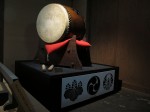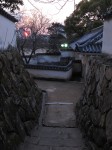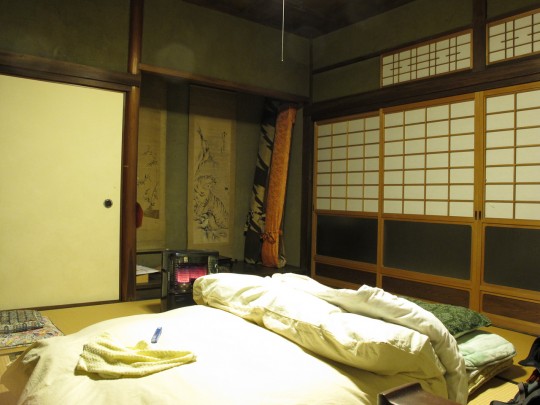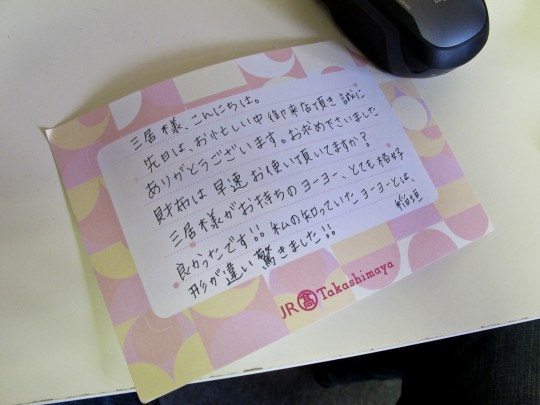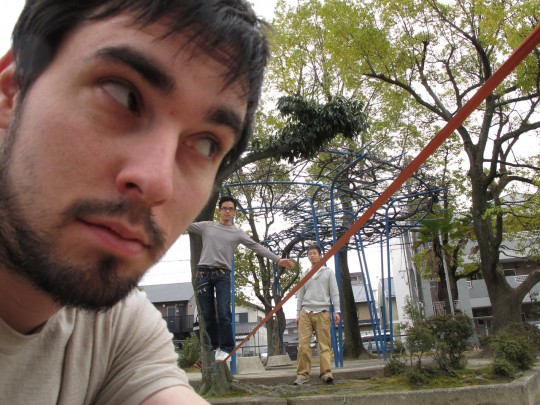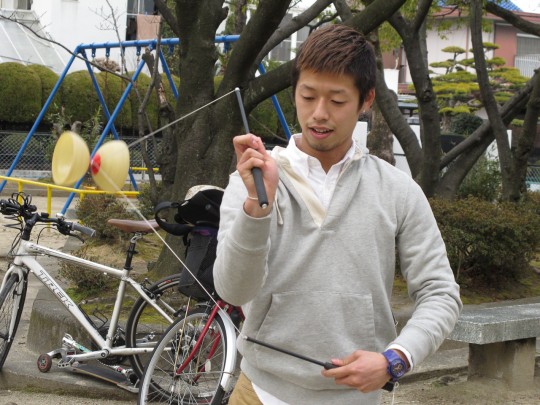Sougenji and Zen Meditation
Wednesday, March 10th, 2010 in: News, Travel
Despite the long day we had, my eyes opened around 6:30am. Keiko and I had talked about going to do Zen meditation at Sougenji, and the session starts at 8. I quickly jumped out of bed and into my clothes, and then back into bed. The morning air is frigid, and old Japanese houses are made of little more than paper.
The two of us crowded into her two-seater “Smart,” an import from the states as evidenced by its left-side driver’s seat. As we zipped down the highway we sipped on some of that tasty hawaiian coffee and had some breakfast sandwiches. We met up with one of Nao-chan’s friends and entered the temple with time to spare.
The main hall was a little more than half the floorspace of a basketball court, with rows of zabuton (sitting pillows) on either side of a wide space facing the dais. the participants filtered into the room and got comfortable on their cushions; several were dressed in blue robes to signify they were in the midst of 修業, ascetic pursuit of knowledge. Most were dressed normally, but seemed to know what they were doing, as they sat down and assumed the full lotus posture with relative easy. Despite years of yoga, I still can’t sit like that for more than a few minutes. So many things I wish I had discovered earlier in my life.
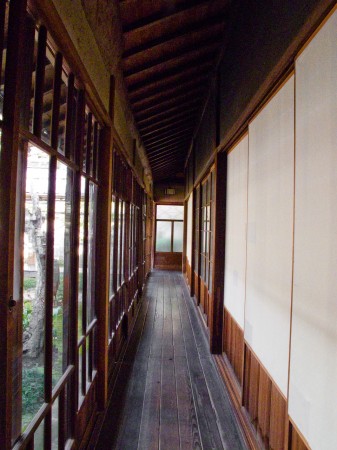 The monk leading the session came out and asked the first-timers to come with him for special instruction. Keiko and I and about three other people slipped away from our places and followed him to an anteroom where he ran over the basic purpose and focus of zen meditation. There was instruction in English available but I was feeling confident enough to catch the gist of things. If Zen is anything, it is the breath. Focus on the breath is the easiest focus exercise we can practice.
The monk leading the session came out and asked the first-timers to come with him for special instruction. Keiko and I and about three other people slipped away from our places and followed him to an anteroom where he ran over the basic purpose and focus of zen meditation. There was instruction in English available but I was feeling confident enough to catch the gist of things. If Zen is anything, it is the breath. Focus on the breath is the easiest focus exercise we can practice.
If you have never meditated , I highly recommend giving it a try. Meditation is practiced by some of the most successful people in the world, and some of the happiest people in the world (I’ve noticed that success and happiness do not always coexist). Take a minute and try to be completely aware of the present moment; let your thoughts about the past and the future slip through your breath as your diaphragm draws down, slowly pulling fresh air into your lungs. When your lungs are filled, pause for a few seconds and feel the stillness within. Even if there’s a lot going on around you, both in the immediate moment and in your world, this moment is complete stillness. Your surroundings have no significance. You see everything without giving it a name, without identifying anything. Now you turn your awareness inward, and take notice of all the thoughts surging within your mind.
The goal of Zen practice is not to reject these thoughts, as suppressing them pumps energy into them just as much as catering to them and focusing on them. Rather, you let these thoughts rise, and without the empowerment of trying to do anything with them they slip back into the abyss from whence they arose. You’re now acknowledging your thoughts and letting them exist without attaching to them, without identifying them. Soon, they stop trying to steal your awareness, and allow you to truly feel the stillness of the moment.
 In this state of stillness it is said that epiphanies can come like a sudden blow. I suppose either to signify this or to help bring it about, or to help bring our awareness to the moment via physical stimuli, there’s a custom of being struck with a large stick during meditation. Halfway through our practice, we stood up for some calisthenics, and when we sat back down, the monks spent the second half of the hour walking slowly down the rows of adherents with a large stick in hand. If you want to be struck, you bow as the monk walks by, and they’ll stop and give you a good whack across the back on each side. It actually felt rather refreshing in the crisp morning air, but unfortunately I let the whole affair distract me a bit as I heard the footsteps pause for intermittent thwacks. I suppose this is an example of the kind of stimuli we learn to let slip past our awareness. I still have a ways to go!
In this state of stillness it is said that epiphanies can come like a sudden blow. I suppose either to signify this or to help bring it about, or to help bring our awareness to the moment via physical stimuli, there’s a custom of being struck with a large stick during meditation. Halfway through our practice, we stood up for some calisthenics, and when we sat back down, the monks spent the second half of the hour walking slowly down the rows of adherents with a large stick in hand. If you want to be struck, you bow as the monk walks by, and they’ll stop and give you a good whack across the back on each side. It actually felt rather refreshing in the crisp morning air, but unfortunately I let the whole affair distract me a bit as I heard the footsteps pause for intermittent thwacks. I suppose this is an example of the kind of stimuli we learn to let slip past our awareness. I still have a ways to go!
At the beginning and end of the practice the monks and practitioners chanted a sutra. I’m not familiar with chants but they’re fun to listen to; it’s sometimes easy to get lost listening to a chant, letting the chorus carry you away from yourself. Afterwards, we returned to the anteroom and had ocha (green tea) with the monk and he answered some questions about the kind of lifestyle he led. Interestingly enough, much of the conversation focused on food and the culture of 上下関係 (seniority). The monks are required to eat more than their seniors, partially because the lifestyle burns more energy than they realize. For every time the senior takes a serving, the juniors must take two. Also, the juniors aren’t done until the senior sets down their chopsticks, so if the senior is 嫌な奴 (a jerk), he’ll eat slowly, and eat a lot. It’s not uncommon to see the younger monks glancing furtively at their seniors, hoping they’re reaching to set down their chopsticks and not to pick up another serving. Another question that came up was whether the monks aspired to be 管長 (head abbot of the monastery) or the head monk of the order, and his response was that there probably weren’t any; such a title was usually thrust upon people; no one sought out that sort of position. The life of a head abbot is full of ceremony and the bureaucracy of being a church official; no moment is left for oneself. In a sense, this sort of promotion prevents true spiritual advancement that draws people to Zen in the first place. Success and happiness don’t always coexist, though they both take many forms.
We briefly strolled around the manicured garden; Ryan told me to feed the koi in the pond, but there were no food bags left in the bin, despite the fish giving me desperate looks, struggling to get as close to me as possible. Fish have no sense of 上下関係. A carefully raked rock garden behind the main hall reminded me of a trip to Ryoanji in Kyoto I took with my fellow exchange students. I took some of my favorite photos there, including one of a bamboo fountain on a stone coin. I told Keiko about it and she explained the significance of the coin:  The square hole becomes a part of the kanji surrounding it, which is why the characters actually written on the coin look incomplete. The four characters are 吾唯足知; 吾、唯、足りるを知る–To understand that just the self is enough/sufficient. I was impressed by the metaphor made by the use of negative space; it’s through the missing elements of these character that their meanings are derived, and the true self is one that sheds the ego and embraces the nothingness, signified by the emptiness in the middle of the coin.
The square hole becomes a part of the kanji surrounding it, which is why the characters actually written on the coin look incomplete. The four characters are 吾唯足知; 吾、唯、足りるを知る–To understand that just the self is enough/sufficient. I was impressed by the metaphor made by the use of negative space; it’s through the missing elements of these character that their meanings are derived, and the true self is one that sheds the ego and embraces the nothingness, signified by the emptiness in the middle of the coin.
httpvh://www.youtube.com/watch?v=ZaJCHEX8p_k
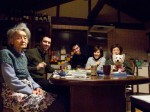 On the way home, we listened to a radio program teaching Mandarin in Japanese. I was suddenly reminded of the plans that were set to take me to China beyond, and once again, I found myself living in the future. At least this time, I could see what was happening instead of just getting absorbed in my thoughts. This allowed me to distance myself from any arising stress the situation was causing, and I napped the rest of the way back to the house. Lunch was waiting for us, and we learned some Japanese sign language from an NHK program as we ate. Our last day in Imbe was running out, so we walked around the neighborhood and visitied a few of the pottery shops the area was famous for. The artisans didn’t disappoint, and I suddenly remembered my host family serving me beer in a bizen-yaki cup my first night at their house, and explaining to me that the glaze does something to enhance the foam, emaking the beer taste that much better.
On the way home, we listened to a radio program teaching Mandarin in Japanese. I was suddenly reminded of the plans that were set to take me to China beyond, and once again, I found myself living in the future. At least this time, I could see what was happening instead of just getting absorbed in my thoughts. This allowed me to distance myself from any arising stress the situation was causing, and I napped the rest of the way back to the house. Lunch was waiting for us, and we learned some Japanese sign language from an NHK program as we ate. Our last day in Imbe was running out, so we walked around the neighborhood and visitied a few of the pottery shops the area was famous for. The artisans didn’t disappoint, and I suddenly remembered my host family serving me beer in a bizen-yaki cup my first night at their house, and explaining to me that the glaze does something to enhance the foam, emaking the beer taste that much better.  I bought them another cup as omiyage for when I visit next month. I’ve been wondering what kind of stuff to get them, and the universe provided for me once again. Dinner that night was delicious steak and veggies, and as we hung around and chatted about our day, Mei-chan curled up in my lap, which put a huge grin on my face and surprised everyone, as she isn’t the type to do that. She must have sensed my inner peace.
I bought them another cup as omiyage for when I visit next month. I’ve been wondering what kind of stuff to get them, and the universe provided for me once again. Dinner that night was delicious steak and veggies, and as we hung around and chatted about our day, Mei-chan curled up in my lap, which put a huge grin on my face and surprised everyone, as she isn’t the type to do that. She must have sensed my inner peace.
Before we went to bed, Ryan and I coaxed a Koto performance out of Nao-chan. It had been years since she’d played, but it was really fun to watch her set up the bridges and play a few tunes for us. Koyuki and Mei-chan made themselves comfortable, and I got the idea to film her playing with a silly run-up with Ryan playing the role of a courtesan opening the shoji screen to reveal her performance. I hope you enjoy it.
httpvh://www.youtube.com/watch?v=qKlx7sVlMmg
I also played around with the koto a little. it’s a fun instrument.
httpvh://www.youtube.com/watch?v=5eoDC5cWe9M
Hadaka Matsuri – Naked Man Festival
Friday, March 5th, 2010 in: News, Travel
I arose from my nap and rubbed dreamily at my eyes. mid-day naps are the best for recharging my batteries, especially considering the strange hours I tend to keep. Tonight’s the big night of the 裸祭り: Hadaka Matsuri, Naked Man Festival. One of Japan’s top three crazy 奇祭, weird festivals, the Hadaka Matsuri consists of thousands of naked men wrapped in loincloths, scrambling for two “lucky sticks” (宝木, Shingi) thrown down from a temple window. The sticks are immersed in incense for two weeks, and smell so strongly that it’s said that if you touch one, you won’t be able to wash the smell off your hands for days. The men who manage to claw their way to the sticks and smuggle them out of the temple grounds somehow are considered extremely lucky (and not just to have survived the ordeal) and are carried on their comrades’ shoulders to a special place where the stick is verified by temple priests and they are proclaimed 福男, fukuotoko, the lucky men. Another custom of note is that presenting your fundoshi to a woman is a surefire way to get her pregnant. I’m not sure if it needs to be unwashed or not… I don’t need that sort of drama in my life right now, so 今年、褌を締めるつもりはない。
 We could see the fireworks in the direction of the temple as we stepped out of the station. lanterns were strewn about town to remind us there was a festival going on. The population density rose as we approached the temple grounds, but we were stopping at Kou’s place first. Ryan warned me that his grandma is very genki (energetic, lively) and will talk forever regardless of whether you understand her or not. My kinda lady! We were close to Kou’s when we had our first Hadaka-sighting (hadaka means naked, but in this situation it’s used as a pronoun for anyone in a fundoshi).
We could see the fireworks in the direction of the temple as we stepped out of the station. lanterns were strewn about town to remind us there was a festival going on. The population density rose as we approached the temple grounds, but we were stopping at Kou’s place first. Ryan warned me that his grandma is very genki (energetic, lively) and will talk forever regardless of whether you understand her or not. My kinda lady! We were close to Kou’s when we had our first Hadaka-sighting (hadaka means naked, but in this situation it’s used as a pronoun for anyone in a fundoshi).  Three nearly naked men were standing outside a brightly lit shop, huddled in a circle and shivering uncontrollably as they furiously sucked down cigarettes, as if the embers from the tobacco would keep them warm if they puffed hard enough on them.
Three nearly naked men were standing outside a brightly lit shop, huddled in a circle and shivering uncontrollably as they furiously sucked down cigarettes, as if the embers from the tobacco would keep them warm if they puffed hard enough on them.
The Hadaka are usually groups of coworkers, friends or colleagues of some sort, turning the whole festival into a sort of deadly teambuilding exercise. To keep warm and build up energy for the coming event, the groups would march through the streets, carrying banners and mikoshi (like small parade floats for festivals), chanting “WASSHOI! WASSHOI!” as the crowd cheers them on. To clear the street for an oncoming group, the police would yell 裸が通ります! Naked guys coming through!
I was a little taken aback at how many foreigners were loitering around the yatai (food stands), and even more were strutting around in fundoshi, looking excited and confused… but I suppose it’s to be expected: Hadaka Matsuri is one of the major “weird festivals” in Japan, right up there with the “Penis Festival,” which has gotten so much press in recent years. You can google that one yourself. My point is that there are many places that experience this phenomenon: small towns with relatively small populations just explode with people once a year. One day there’s nary a soul in sight (like when we checked out the temple the day before), and the next the streets are completely choked with bodies. In the fall, even Imbe is jam-packed with people for the Bizen-yaki Pottery Festival.
 Kou’s grandmother was as advertised, a slight but sprightly woman, 92 years young. She was very excited to have us over, smiling broadly and offering us homemade sushi and hot tea. Her hearing wasn’t so great but it didn’t matter so much; we let her do most of the talking with her thick Okayama dialect. When there was something worth saying, I had Kou translate from either English or standard Japanese into Okayama-ben, about 30 decibels louder. She was a lot of fun.
Kou’s grandmother was as advertised, a slight but sprightly woman, 92 years young. She was very excited to have us over, smiling broadly and offering us homemade sushi and hot tea. Her hearing wasn’t so great but it didn’t matter so much; we let her do most of the talking with her thick Okayama dialect. When there was something worth saying, I had Kou translate from either English or standard Japanese into Okayama-ben, about 30 decibels louder. She was a lot of fun.
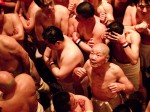 We were running out of time, and Kou’s mom (who also volunteered at the temple) scored us tickets to actually go into the temple and view the Hadaka from the window they perform the 宝木投下 (airdrop of the lucky sticks). We were the last ones into the Temple, so we got to watch the Hadaka gathering on the veranda underneath the window, jostling for a good position, shivering in the cold, and keeping their arms raised to avoid being pushed to the ground and trampled.
We were running out of time, and Kou’s mom (who also volunteered at the temple) scored us tickets to actually go into the temple and view the Hadaka from the window they perform the 宝木投下 (airdrop of the lucky sticks). We were the last ones into the Temple, so we got to watch the Hadaka gathering on the veranda underneath the window, jostling for a good position, shivering in the cold, and keeping their arms raised to avoid being pushed to the ground and trampled.  There are a lot of injuries at this festival, most of them due to the sheer number of people pressing against each other; it’s like a tsunami of human bodies, a force of nature. More on that later. A temple worker was ladling water out of a bucket and throwing it out over the crowd–this was to help prevent epic rug burns. Each time water was splashed on the crowd, the men would shout in excitement. The temperature was rising in more than one way. As the crowd thickened, steam began to rise off their bodies; if it weren’t for the water, they would surely have caught on fire from all the friction.
There are a lot of injuries at this festival, most of them due to the sheer number of people pressing against each other; it’s like a tsunami of human bodies, a force of nature. More on that later. A temple worker was ladling water out of a bucket and throwing it out over the crowd–this was to help prevent epic rug burns. Each time water was splashed on the crowd, the men would shout in excitement. The temperature was rising in more than one way. As the crowd thickened, steam began to rise off their bodies; if it weren’t for the water, they would surely have caught on fire from all the friction.
httpvh://www.youtube.com/watch?v=5girTjwEmFI
We were the last ones ushered out of the temple before the priests held their secret ceremony to bless the Shingi. I stepped out of the side entrance to the temple and back into my shoes. The sea of people had parted to create a path that wound around the temple grounds, allowing the increasing flow of Hadaka into the main staging area for the upcoming battle. We still had a while to before the actual event would take place, so Kou led us around the food stands and we picked up some castella from his favorite yatai. The ojisan running the stand recognized Kou and they exchanged some friendly words as he ejected the hot spongecakes from their iron moulds. Not many castella carts cook their cakes to order, which is what brings Kou back to this particular yatai every year. Our breaths were already visible in the crisp night air, but now we spouted steam like hot kettles; our tongues danced to avoid the molten bread swirling in our mouths. I bought another bag.
httpvh://www.youtube.com/watch?v=uq3u1l20QlQ
As I had mentioned before, tonight was the 500th anniversary of the Hadaka Matsuri at Saidaiji. There are many local festivals like it around the country, but this is the biggest and longest-running event of its kind. Tonight also marked a surprising change of pace, which seemed to throw everyone working the festival for a bit of a loop: instead of the traditional dropping of the sticks at the strike of midnight, the shingi touka was moved up to 10pm. Various reasons were cited for the change, and from what I gathered, it was partly a safety precaution for the crowds and for the participants, but I suspect it was also to help ensure that all the people who had commuted in to see the event wouldn’t miss the last train of the evening. I’m sure the yatai workers and cabbies weren’t too happy about their profits for the night being cut short, and there was much confusions amongst the event staff; it’s hard to break a 500 year habit.
When we first got into Okayama, Keiko’s friend (the bringer of delicious coffee) told us about the time he donned a fundoshi and joined the festival, 30 or 40 years ago. He gave us a good idea of what to expect, and explained the dangers and etiquette (why the men have to keep their arms above their shoulders, why they get doused with water, no punching or kicking, just pulling and scratching, and so on. Even with his help, I was not prepared to see so many naked men crowded around the temple, pressing themselves up the steep wooden steps, groping for two incense sticks. There was a 500 yen viewing area, a 1000 yen standing area, and 5000 yen seats immediately across from the temple. All were sold out by the time we got back to the temple grounds from our snack run. We made our way down to the grounds between the viewing areas and the temple, and though we had to swim through a thick fog of onlookers, we found that we had a better view than if we had paid. I almost had a clear shot of the writhing mass of bodies if it weren’t for a corner of the pagoda, but it was the best I could hope for. The crowd was so tightly packed together, I had to wonder who was in more danger, us or the Hadaka. The events that followed soon put that thought to rest.
httpvh://www.youtube.com/watch?v=nX_79DtCpLY
When the clock struck ten, the floodlights were all shut off at once, and the sticks were thrown into the darkness. The crowd went wild, and the flashes from a thousand cameras illuminated the violence like a giant naked all-male nightclub. Eventually some of the lights were turned back on, and you could barely make out the action. The men were so tightly packed on the platform that more than once a massive wave of them came tumbling down the stairs, sending ripples out into the crowd of Hadaka still plying their way toward the temple. The intensity of the situation was punctuated by the presence of hundreds of medical workers already hauling wounded men out of the area. Men on the platform and on the ground were yelling and pointing towards the center of the crowd, either trying to direct their friends or misdirect their opponents. At one point I swear I saw one of the Hadaka squeeze out of the side of the crowd and down the steps towards the exit. It seemed like one of the Shingi was making its way to freedom.
httpvh://www.youtube.com/watch?v=ado–jg14M4
Eventually a voice came over on the loudspeakers announcing that it “seems that the shingi has been taken from the temple grounds.” Once the shingi crosses the gate, it’s considered a done deal; any fighting beyond that point disqualifies you. Kou shook his head and said that it’s often a ruse to get the Hadaka to calm down a little bit, even if the Shingi is still around. The veterans know this, and continued their valient struggle. Several confused-sounding announcements later, the Hadaka had finally had their fill of the fighting, and had resorted to standing around, grasping their sides and shivering in the wind. The crowd was so massive that the men on the temple floor were forced to wait for 20 minutes before they were able to descend from the platform.
httpvh://www.youtube.com/watch?v=KhMBlnTK8Uc
Kou led us to the building just outside the temple grounds where the fukuotoko were brought for verification. TV camera crews and curious bystanders lined the streets and waited for the sound of the whistle and the triumphant shouts of “WASSHOI, WASSHOI!” as the first, and then second fukuotoko were carried into the building.
httpvh://www.youtube.com/watch?v=JxRfs9pqEZI&NR=1
Having seen almost everything the Hadaka Matsuri had to offer, we turned back to Kou’s house to recap the night’s events for his mother and grandmother, and to enjoy some more delicious food before heading back to Imbe. Kou asked me to perform a few yo-yo tricks and he brought out his new Hyper Yo-Yo he had picked up at Bic Camera the day before. It was really cool to see someone pick up a yo-yo again and try it after all these years. The evening ending on a happy note, Kou’s mom drove us back to the station, and he even bought a ticket to enter the platform for 見送り, seeing us off. I had forgotten about this custom and was a little surprised at first, but then I realized that he and Ryan had a long history together and they don’t see much of each other, and this was the last time this trip we’d be able to meet. When the train pulled away, Kou began to run alongside it, waving vigorously the whole time. We waved back and laughed to each other until he disappeared into the distance. We sank into our chairs, completely spent from all the festivities. A mountain hike, good food, good friends, and a bunch of naked men… what more could you ask for?
Hiking Mt. Kumayama
Saturday, February 27th, 2010 in: News, Travel
“When I lived here, I did this hike every day” Ryan proclaimed as we wound our way up the mountain trail. There was pride in his voice, but not because of his accomplishment, but because of the privilege he felt for being able to make this hike on a daily basis. He was glad to have someone to share it with who would appreciate just how lucky he was to have the opportunity to do this on a daily basis. His wife grew up here, and as we often are about things we grow up with, the novelty has worn off for her. We have to constantly forget in order to retain that sense of wonder, to see the world with fresh eyes. At least, that’s my excuse for having a poor memory. That aside, she doesn’t really care for hiking.
We reached the first summit relatively quickly, thanks to the steep stairs on the more direct route. This was the only the first mini-mountain we’d be hiking today, but I was already stripping off layers to get more comfortable, and struggling to relax my breathing pace. I’m definitely out of shape. If I had any breath the view would have stolen it from me. What an amazing place to call home. I know there will be many more hikes and many more mountains to come, but this one felt so comfortable to be on, I forgot where I was and just breathed it all in for a moment.
Descending back to the ridge that connected us to the next peak, we stood under the massive electrical tower waiting for Keiko (Ryan’s mother-in-law) and Koyuki (her Maltese) to come up from the less-direct path. The rolling hills were slathered with green, a sharp contrast to the cold grey of the power lines stretching from ridge to ridge. These cables must be more than a kilometer long; a marvelous feat of engineering, though they’re kind of spoiling the view. I wondered what it would be like to walk across them, to be suspended in the air, far above the business of the ground-dwellers, but standing on the veins that carry its lifeblood. I’ll bet the view is even more spectacular between the mountains than on top of them.
 I shook off the thought as Koyuki came bounding up the trail. We rejoined Keiko and trudged up to the next summit, a few hundred meters away with a sharp elevation gain. The small city of Imbe was shrinking from sight, disappearing behind mountains and the spider web of power lines draped across the landscape. Did we want to head back yet, or continue on to Kumayama? It was a question that need not be asked.
I shook off the thought as Koyuki came bounding up the trail. We rejoined Keiko and trudged up to the next summit, a few hundred meters away with a sharp elevation gain. The small city of Imbe was shrinking from sight, disappearing behind mountains and the spider web of power lines draped across the landscape. Did we want to head back yet, or continue on to Kumayama? It was a question that need not be asked.
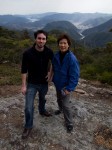 Keiko and I discussed a variety of things, mostly revolving around the topics of language and culture, and the differences between Japan and America. I don’t know what it is, but older Japanese women and I really get along. I feel so relaxed that I don’t feel so self-conscious about my Japanese, which seems to loosen my tongue and give me a real chance to stretch my abilities. I feel like I can actually express myself , and our conversations almost always seem to end in a greater mutual understanding of each other and our cultures. Hanging out with my friends and coworkers who are mostly guys my age, I feel stuck and trip over my tongue. I can never find the right words, and I feel lost in their conversations. I don’t know what it is, but I sometimes have a better time talking to my friends’ moms than people my age.
Keiko and I discussed a variety of things, mostly revolving around the topics of language and culture, and the differences between Japan and America. I don’t know what it is, but older Japanese women and I really get along. I feel so relaxed that I don’t feel so self-conscious about my Japanese, which seems to loosen my tongue and give me a real chance to stretch my abilities. I feel like I can actually express myself , and our conversations almost always seem to end in a greater mutual understanding of each other and our cultures. Hanging out with my friends and coworkers who are mostly guys my age, I feel stuck and trip over my tongue. I can never find the right words, and I feel lost in their conversations. I don’t know what it is, but I sometimes have a better time talking to my friends’ moms than people my age.
If he grew quiet for too long, I would periodically recap for Ryan to keep him in the conversation. It’s hard to know the proper etiquette when speaking Japanese in the presence of other non-native speakers; am I being condescending or helpful? How much should I assume they understood? It depends on the person; I think some people wave off a helping hand even if they need it. Ryan seemed happy to be a part of the conversation, and I’m hoping that it’s encouraged him to redouble his efforts to study the language. He’s already put a lot more work into it than some of the other expats I’ve met; I must commend him for being so bold and picking up Japanese from scratch in order to communicate with his extended family.
 We reached the summit of Kumayama and were greeted with a strong gust of wind and a view of more powerlines connecting the dots of towns spattered across the landscape. An ancient ruin not unlike the Mayan pyramids remained as a reminder of a past long forgotten; an information board laid out the suspected timeline and purpose of the structure, but in the end it was pretty clear that nothing was known for sure about its purpose. A man from Kobe who was in the area on business started up a conversation with me and remarked that seeing a foreigner in a place like this was in a way more of a rare sight than the ruins he came to see. We shared a laugh about it, but my laughter was derived from the irony that I’ve never thought of myself a rarity, but if I was alone and ran into another gaijin on the trail, I would probably have the same reaction.
We reached the summit of Kumayama and were greeted with a strong gust of wind and a view of more powerlines connecting the dots of towns spattered across the landscape. An ancient ruin not unlike the Mayan pyramids remained as a reminder of a past long forgotten; an information board laid out the suspected timeline and purpose of the structure, but in the end it was pretty clear that nothing was known for sure about its purpose. A man from Kobe who was in the area on business started up a conversation with me and remarked that seeing a foreigner in a place like this was in a way more of a rare sight than the ruins he came to see. We shared a laugh about it, but my laughter was derived from the irony that I’ve never thought of myself a rarity, but if I was alone and ran into another gaijin on the trail, I would probably have the same reaction.
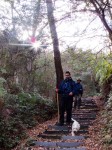 We walked back wishing we had planned better and brought some food with us; it was already 3 in the afternoon and we hadn’t eaten since our light breakfast. Koyuki was also visibly ready to get back, but never straying out of our sight. A surprisingly good hiking companion for a creature with such short legs. By the time we got to the final descent into the valley, I was literally running down the stairs, barreling towards lunch. Koyuki got the message, and started bounding down after me. I was reminded of a story I read in Einstein’s Dreams, where the faster you move, the slower time goes (although by immeasurably miniscule amounts), so people are either frantically trying to move as fast as possible so they can live longer, or they just go about their business as usual. The people who try to squeeze every last millisecond out of life end up running past it and forgetting to savor the moments that make it up.
We walked back wishing we had planned better and brought some food with us; it was already 3 in the afternoon and we hadn’t eaten since our light breakfast. Koyuki was also visibly ready to get back, but never straying out of our sight. A surprisingly good hiking companion for a creature with such short legs. By the time we got to the final descent into the valley, I was literally running down the stairs, barreling towards lunch. Koyuki got the message, and started bounding down after me. I was reminded of a story I read in Einstein’s Dreams, where the faster you move, the slower time goes (although by immeasurably miniscule amounts), so people are either frantically trying to move as fast as possible so they can live longer, or they just go about their business as usual. The people who try to squeeze every last millisecond out of life end up running past it and forgetting to savor the moments that make it up.
I felt a little guilty for not taking a slower pace and enjoying the descent, but I had a meal and a nap waiting for me at the bottom of the hill that I was more interested in savoring.
Meeting the Ex-pats
Friday, February 26th, 2010 in: News, Travel
Sean and Anton are American and Canadian expats, having lived in Japan for 10 and 5 years, respectively. Sean’s been married almost his whole time here, has two children and just bought a parcel of land to build his first house. Anton is recently married and like Ryan, is hoping for a kid sometime in the next year. It was really interesting to talk to them about their experiences living here. Their triumphs and frustrations, the same kind of junk families go through anywhere. Some cultural quirks unique to Japan that make life easier or harder for them.
 Surprisingly, they’ve managed to live here for years without seriously taking on the language. Ryan has been trying harder lately, but works in an all-English office at Ikea. English teachers get by on their language, so I guess it’s not so important for them to know more than the basics in Japanese… but I couldn’t imagine living in a country where I felt lost in translation… I couldn’t marry someone if I didn’t have a firm grasp of her native language, if I couldn’t communicate with her family. A lot of culture is imbued in a language; from language study you learn a lot about the people who speak it. I might get frustrated with myself for not being able to communicate on a high enough level, after all the efforts I’ve put into learning Japanese, but I would hate to get frustrated with those around me because of my failure to try to understand them… That’s not to say that there’s anything wrong with the lives they’ve carved out for themselves here, but I don’t think I could live my life in that way. I’m glad there are so many people in this world to teach me the value of variety of perspective. I learn a lot more about myself through them.
Surprisingly, they’ve managed to live here for years without seriously taking on the language. Ryan has been trying harder lately, but works in an all-English office at Ikea. English teachers get by on their language, so I guess it’s not so important for them to know more than the basics in Japanese… but I couldn’t imagine living in a country where I felt lost in translation… I couldn’t marry someone if I didn’t have a firm grasp of her native language, if I couldn’t communicate with her family. A lot of culture is imbued in a language; from language study you learn a lot about the people who speak it. I might get frustrated with myself for not being able to communicate on a high enough level, after all the efforts I’ve put into learning Japanese, but I would hate to get frustrated with those around me because of my failure to try to understand them… That’s not to say that there’s anything wrong with the lives they’ve carved out for themselves here, but I don’t think I could live my life in that way. I’m glad there are so many people in this world to teach me the value of variety of perspective. I learn a lot more about myself through them.
Naoshima
Friday, February 26th, 2010 in: News, Travel
Our trip only halfway over, we boarded our second ship of the day. Naoshima was our destination, a larger island Southwest of Inujima. Home to another host of art installations and museums, the view was gorgeous but the wind was fierce, a chill rising off the inland sea.
 The thing we saw was a giant red pumpkin on the ferry docks. A glimpse of what’s to come? We took a bus to the other side of the island. We walked from a public campground where Kou spent some time as a child, and came across anothergiant pumpkin on the beach. Walking up the hillside past a fancy hotel, there were more public works waiting for us. Kou suggested we check out one of the art museums on the hill. We walked up to Bennesse House, and a stone retaining wall was just begging to be climbed. I traversed for a while, and against Ryan’s better judgment, topped out before reaching the corner. I sat for a moment for a photo, and as I jumped down the other side, saw one of the desk staff running out with a stern look on his face and menacing body language. Clearly, This was not the kind of place to fool around.
The thing we saw was a giant red pumpkin on the ferry docks. A glimpse of what’s to come? We took a bus to the other side of the island. We walked from a public campground where Kou spent some time as a child, and came across anothergiant pumpkin on the beach. Walking up the hillside past a fancy hotel, there were more public works waiting for us. Kou suggested we check out one of the art museums on the hill. We walked up to Bennesse House, and a stone retaining wall was just begging to be climbed. I traversed for a while, and against Ryan’s better judgment, topped out before reaching the corner. I sat for a moment for a photo, and as I jumped down the other side, saw one of the desk staff running out with a stern look on his face and menacing body language. Clearly, This was not the kind of place to fool around.
We entered anyways, despite the doorman’s disapproving glance, and paid the 1,000 yen entrance fee. The desk staff waited until after we had paid to remind us that photography was strictly forbidden. Ryan suddenly remembered that a friend of his was chased down and ejected from the building after being caught sneaking photos. Clearly, this wasn’t the kind of place to break the rules. I fought the urge to ask for a refund.
The art itself, was a bit disappointing. There were a couple names I recognized; an unnamed Jasper Johns piece and a late Jackson Pollock “triptych,” but it wasn’t particularly remarkable. One of the museum staff in the room rounded the corner and eyed us seriously. The only information he offered was that it was a very expensive painting. Thanks. One interesting piece was a huge networked grid of ant farms where the sand was dyed to look like the flags of the world. The farms were interconnected, so the ants were free to travel internationally, illegal immigrants burrowing their way through the beaches of the world. Some of the flags had already crumbled into technicolor piles at the bottom of their plexiglass frames; victims of their own popularity. Tourist destinations don’t always benefit from their success. I didn’t know the artist; I would have taken a photo of the byline if the hounds weren’t about. Other than that there wasn’t much. Some more disinterested gallery staff sitting about, watching us closely but careful to avoid meeting our gaze, lest we actually have a question about the scant artwork peppering the building. Kou commented on just how sour the atmosphere was, and how unacceptable it was from a Japanese perspective.
The final room we entered was a large concrete rotunda that must have cost millions of dollars to build. A spiral walkway led the way back to the main lobby. The only piece of art was a large board with a hundred neon signs that read some variation of “verb and live,” “verb and die.” Eat and live, eat and die, sleep and die, kill and live. They lit up randomly. We were more impressed that they had such an enormous chamber dedicated to a single piece of art than the art itself. Ah well, that’s the kind of place it is.
We walked back to the ferry station where the first pumpkin was and jumped on the ferry back to the mainland. We had to get back to meet up with some of Ryan’s old fellow Nova teachers for some dinner. Waiting for the bus, I practiced yo-yo a little, and Kou talked about how he used to yo-yo a little back when he was in Junior High School. When we got back to Okayama and met up with the guys, Kou had to split off to go home, but first ducked into Bic Camera to pick up a yo-yo for himself. Glad to have spread the love around a little!
Inujima Art Project
Friday, February 26th, 2010 in: News, Travel
Today I managed to wake up at a reasonable hour and we quickly got under way to meet with Ryan’s friend Kou, an old student from his Nova days. Kou lives near Saidaiji and volunteers at the temple, where the Naked Man Festival has been held annually for the past 500 years. Kou was as advertised, a quiet, laid back guy, though he wasn’t wearing his trademark Doraemon t-shirt. He showed us the temple grounds, eerily empty except for workers setting up barriers to protect the ancient buildings from the throngs of people that will be filling the courtyard for the festival. In just over 24 hours, this part of town is going to be choked with naked men and onlookers.
 We took a bus to the shore to take the ferry to Inujima, detouring a little to check out the beach. Some sweet old ladies asked us where we were heading, and told us to get the lead out. We thanked them and ran to the ferry, where we had only a couple minutes to buy our tickets and board the small ship, taking a seat next to a few people and a laundry machine bound for one of the island’s inhabitants. One of the other passengers turned out to be a friend of Shinji’s (the photographer from the day before), and we learned that he owns a coffee house that Ryan used to frequent when he lived in the area. It’s a small world, 世間は狭いね。
We took a bus to the shore to take the ferry to Inujima, detouring a little to check out the beach. Some sweet old ladies asked us where we were heading, and told us to get the lead out. We thanked them and ran to the ferry, where we had only a couple minutes to buy our tickets and board the small ship, taking a seat next to a few people and a laundry machine bound for one of the island’s inhabitants. One of the other passengers turned out to be a friend of Shinji’s (the photographer from the day before), and we learned that he owns a coffee house that Ryan used to frequent when he lived in the area. It’s a small world, 世間は狭いね。
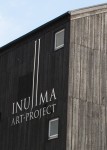 The island itself was a small slice of granite defiantly jutting out of the inland sea, battered by years of typhoons, and carved up for use in castle foundations. Before the war it was used for copper refinery, and a lot of the old factory buildings were made from Karami-renga, カラミ煉瓦, bricks made from the slag left over from the smelting process. The dense bricks were pockmarked and scarred from the mineral imperfections that characterized them; each stone weighed over 40 pounds.
The island itself was a small slice of granite defiantly jutting out of the inland sea, battered by years of typhoons, and carved up for use in castle foundations. Before the war it was used for copper refinery, and a lot of the old factory buildings were made from Karami-renga, カラミ煉瓦, bricks made from the slag left over from the smelting process. The dense bricks were pockmarked and scarred from the mineral imperfections that characterized them; each stone weighed over 40 pounds.  Several chimney stacks, relics from the refinery and rare pre-modern electric plant, sprung from the ground, some looking as good as new, others had suffered greatly over time, and were on the brink of collapse. During the war, the island was used as a munitions plant, and was bombed by the Americans. Afterwards, the Japanese tried to tear down some of the chimneys to use the building materials elsewhere, but found they were too sturdily built to easily harvest for materials. At its apex, three to five thousand people lived on the island; nowadays, the population is 44. In recent years, The island’s been rehabilitated in the form of a massive art project by an architect (Hiroshi Sambuchi) and an artist (Yukinori Yanagi). The main point of the structure was to utilize the giant chimney to help create a controlled environment by directing airflow between a hot and cold wing of the building. We walked into a dark winding corridor with mirrors set up to make it seem straight. At the start of the path was a 3D sun, symbolic of the power of nature. At the other end of the path was a final mirror turned upwards to the sky. Don’t tell anyone I snuck a few photos…
Several chimney stacks, relics from the refinery and rare pre-modern electric plant, sprung from the ground, some looking as good as new, others had suffered greatly over time, and were on the brink of collapse. During the war, the island was used as a munitions plant, and was bombed by the Americans. Afterwards, the Japanese tried to tear down some of the chimneys to use the building materials elsewhere, but found they were too sturdily built to easily harvest for materials. At its apex, three to five thousand people lived on the island; nowadays, the population is 44. In recent years, The island’s been rehabilitated in the form of a massive art project by an architect (Hiroshi Sambuchi) and an artist (Yukinori Yanagi). The main point of the structure was to utilize the giant chimney to help create a controlled environment by directing airflow between a hot and cold wing of the building. We walked into a dark winding corridor with mirrors set up to make it seem straight. At the start of the path was a 3D sun, symbolic of the power of nature. At the other end of the path was a final mirror turned upwards to the sky. Don’t tell anyone I snuck a few photos…
At the other end of the structure was another art installation, a “floating room” inspired by the novelist Yukio Mishima. Everything was suspended from the ceiling, over a slab of stone cut out of the granite quarry on the island. Just outside of this was a room with a set of opposing mirrors upon which lasers were used to create infinitely recursive messages. It was a very cool effect. The final installation was in the “hot room,” a glass structure that was at least 10 degrees celsius warmer than the rest of the building. During the summer, it was said to reach 80 degrees if the proper doors weren’t opened to regulate the temperature. The art installation consisted of gilded sentences taken from Mishima’s work, draped around an old war chest. Since I haven’t had a chance to read Yukio Mishima, I’ll have to refrain from commenting on the art; maybe if I get a chance I’ll catch up on my reading and I’ll be able to speak more about it.
Attached to the “hot room” was a modern cafe, but our ride for Naoshima was leaving in less than 10 minutes.
Korakuen and Okayama Castle
Thursday, February 25th, 2010 in: News, Travel
Ryan’s an early bird, I am not. I don’t remember if I asked him to wake me, probably because we both assumed I would wake up before 10am. I rolled out of bed at noon, wiping the sleep from my eyes and apologizing for the late start. We had a pretty free day, so it was no big deal. Don’t let me sleep in like that again, I admonish Ryan, as if it were his fault.
We have to run to the station to catch our train; only one every hour stops at Imbe, which is quite a change of pace from what I’m used to in the cities. Our destination is Korakuen (後楽園), the first public garden in Japan, but first, we stop at an old friend’s photo studio to hang out for a bit. Some more delicious coffee, this time from a french press. Ahh, I like how the people here think. Shin-san’s a talented photographer, and gave me some good advice on my product photography for the store. I had never had such an in depth conversation about a specialized topic in Japanese before; I couldn’t help but feel a little proud of myself.
The park itself was like stepping into a time warp; the meticulously manicured garden had been carefully looked after for a long time. This was confirmed later when we went back home and Grandma showed us photos from when SHE was our age, before the war. Though the images had faded with time, the park looked exactly as it does today. Grandma is a quiet lady, but when she talks about the past, her eyes light up and her voice fills with laughter. The tragedy of growing old is your recollections become littered with the dead. This is my son, isn’t he handsome? He died of a heart attack. This is my husband, he passed away when he was 30. This is my junior high school class, we still get together every year. There’s only four of us left, now. She’s been cursed with the blessing of longevity, left behind by those she loved, isolated from the modern world; she references her faded images and letters to rekindle the memories of the life she stopped living long ago.
Satisfied with the moments we captured in the park, we moved on to the castle on the other side of the river. Just as well preserved as the park it faced, except the castle had been rebuilt since the war, a victim of the firebombings. There seems to be two kinds of castles in Japan: the drafty, dark ones, preserved or rebuilt as they looked hundreds of years ago, and the ones that’ve been rebuilt as brightly lit flourescent museums. This one was the latter, the smell of history hidden behind sheets of glass. I learned a lot about how we treat our past today.
To Okayama!
Thursday, February 25th, 2010 in: News, Travel
When I climbed with Ryan the other week, we briefly talked about the upcoming Hadaka Matsuri (裸祭り, naked man festival). There are several around the country, including one in Nagoya at the end of the month. He mentioned that he was going to the one in Okayama, to which I replied “Okayama? Why the heck would you go all the way out there!?” It’s where his in-laws live, and it’s really his second home.
Later on, we were chatting on facebook, and it became apparent that there’s more in Okayama than just relatives and naked men. Aside from being on the inland sea, just north of Shikoku, Okayama is home to quite a few interesting spots, including the birthplace of the legend of Momotaro (famous Japanese tale), an area famous for its swordsmiths, gorgeous hikes and the first public school and park in Japan. The in-laws live in the heart of Bizen, famous for its special pottery. To sweeten the deal, the Hadaka Matsuri at Saidaiji (西大寺) is the largest in the country, and this year marks the 500th anniversary for the event at that temple. You can’t find tradition like that back home… Despite the cost of traveling in Japan, I was feeling a little stir-crazy, working so feverishly to get the site set up, and I think I needed a little break from things. If I could get enough done before Wednesday, I was in for the full 5 days. Ryan’s in-laws were gracious enough to put out an extra futon for me, and he said that my only penance would be to hang out with his mother in-law and drink beer and speak Japanese with her. I think I can handle that.
 Packing aside, I needed to get myself a little more presentable before I leave. I hadn’t shaved since I left the states (I was trying to wait until our site was complete, but really I was just being lazy). So off came the beard… well, at least the stache and cheek-scruff. Eager to test out the ruggedness of my gear, I limited myself to two of everything, but only one pair of my wool underwear (too much information, you say?). 5 days of hiking and sightseeing, this is a pretty good stress test I’d say.
Packing aside, I needed to get myself a little more presentable before I leave. I hadn’t shaved since I left the states (I was trying to wait until our site was complete, but really I was just being lazy). So off came the beard… well, at least the stache and cheek-scruff. Eager to test out the ruggedness of my gear, I limited myself to two of everything, but only one pair of my wool underwear (too much information, you say?). 5 days of hiking and sightseeing, this is a pretty good stress test I’d say.
I jammed on the work until 6pm, and ran out the door. Once I got to the station I realized that we should have specified where to meet, because there were several Shinkansen (bullet train) ticket counters, and I kept getting a “the person you are trying to reach is not available” message. I posted myself outside the main ticket office and within a few minutes Ryan appeared with a huge sigh of relief, waving his dead phone. “My wife has my phone charger!” That could’ve been a serious dampener on the weekend if he hadn’t spotted me!
 I just need to take a second to say this… the Japanese train system is simply amazing. For traveling long distances, the shinkansen is like a dream. It’s… better than a plane. You have to experience it to understand what I mean. We glided in smooth, quiet comfort for around two hours before we arrived at Okayama station, and switched to a local train to get to Imbe. Despite being at least 30 years old, the local train was still very clean and comfortable. 9 stops later we arrived at Imbe. A single track and no turnstiles, just a box for you to put your ticket. I suddenly understood why the conductor was going around checking people’s tickets on the train… This station was old-school.
I just need to take a second to say this… the Japanese train system is simply amazing. For traveling long distances, the shinkansen is like a dream. It’s… better than a plane. You have to experience it to understand what I mean. We glided in smooth, quiet comfort for around two hours before we arrived at Okayama station, and switched to a local train to get to Imbe. Despite being at least 30 years old, the local train was still very clean and comfortable. 9 stops later we arrived at Imbe. A single track and no turnstiles, just a box for you to put your ticket. I suddenly understood why the conductor was going around checking people’s tickets on the train… This station was old-school.
 The house was a two minute walk from the station. I let Ryan enter first, and he popped his head in the kitchen with a hearty “tadaima! I’m home!!” Koyuki, the family dog, excitedly jumped up to greet him. I waited for his signal to pop my head in the doorway. “ojama shimasu”
The house was a two minute walk from the station. I let Ryan enter first, and he popped his head in the kitchen with a hearty “tadaima! I’m home!!” Koyuki, the family dog, excitedly jumped up to greet him. I waited for his signal to pop my head in the doorway. “ojama shimasu”
Ryan’s wife, her mother and grandmother, sister and her fiancee, and a family friend were all cozily hanging around the dining table. I joined into their lively conversation, letting them take the lead. Where are you from? How do you know Ryan? What brings you to Japan? How did you learn to speak Japanese so well?
 I felt oddly at ease, it felt a lot like hanging out with my host family years ago. The friend had brought some delicious coffee back from Hawaii; I hadn’t had good coffee in a few weeks, and I felt a little bad but I couldn’t help but ask for seconds. After everyone had left, I was asking Keiko (Ryan’s mother-in-law) about the temple hike in Shikoku, and she revealed a nearly-completed scroll of the 88 temples on the island. She’s been slowly visiting them all over the years, and showed me a book about the hike around the island and the pilgrims who follow it, some for decades. I wish I had that kind of conviction, I was tentatively considering spending a month on the trail myself, if I make it back to the island.
I felt oddly at ease, it felt a lot like hanging out with my host family years ago. The friend had brought some delicious coffee back from Hawaii; I hadn’t had good coffee in a few weeks, and I felt a little bad but I couldn’t help but ask for seconds. After everyone had left, I was asking Keiko (Ryan’s mother-in-law) about the temple hike in Shikoku, and she revealed a nearly-completed scroll of the 88 temples on the island. She’s been slowly visiting them all over the years, and showed me a book about the hike around the island and the pilgrims who follow it, some for decades. I wish I had that kind of conviction, I was tentatively considering spending a month on the trail myself, if I make it back to the island.
Bedtime already, I was shown to my room, a beautiful washitsu with a plush futon, all to myself. I lay down, feeling blessed to know such people. Whether it was my recent sleeping habits or the coffee pulsing through my veins, I couldn’t get to sleep right away. Thoughts and memories mixed together, burning into my mind with a taunting wakefulness. Tomorrow’s a big day. I finally slip into a restless sleep, continuing the dream that kept me from the darkness.
A note on Japanese Service
Thursday, February 25th, 2010 in: News
Last week, we did a little shopping in Nagoya station. Although the total amount of floor space dedicated to the train station itself is not exceptional, including the two massive skyscrapers jutting out of the station, it’s considered the “largest” train station in the world. Hiro has been using the same wallet for 4 or 5 years, and now that he’s a bigshot CEO, it’s time for him to have a wallet that matches his social stature.
After wandering around the various shopping levels in the station, we found the brand range we had been looking for. Dunhill, Chanel, Calvin Klein and Coach stores wound around the escalators with a menacing sense of luxury. These are the companies that have established themselves as quality brands, and have grown fat off their reputations.
Hiro decided on a Burberry wallet that caught his eye. Only mildly interested in such things, I wandered out to the front of the store and took out my yo-yo for some much-needed practice. When I came back, the sales lady asked us about the yo-yos, and was really impressed with the strange shape and color of the ones we carried. Not like any she’s seen before, she remarked.
She carefully wrapped Hiro’s new wallet up like it was a gift, and escorted us to the store’s threshold before presenting the bag to Hiro. With a deep bow, she ushered us out the store and thanked us for our visit. Each time I looked back, she would either wave or bow again until we were out of sight. In Japanese, 見送り。
Hiro went on to explain that for him, this is the real reason to come to stores like this; yes, the quality of the products is very high, but it’s the level of service that really sets them apart. Whereas I would be satisfied with a sturdy product that I bring to a counter and just pay for; there seems to be a borderline obsession with the quality of service and the actual shopping experience here in Japan. Many a time would my friends remark on the service of this or that place, noticing minor details in the way they acted or spoke that I never bothered to pay attention to or listen for. Perhaps this is why customer service here has developed into such a major facet of doing business. It’s hard to describe, really; I would call it “professional” friendly, as opposed to “personable” friendly. The barrier of politeness often prevents the interaction from breaching true conversation, but it’s not an unpleasant experience at all. I guess sometimes I’m more curious about the people providing the service for me, which causes me to resent the walls that have been built around us. I sometimes feel like with all the ultra-polite set phrases and trained responses, it’s easy to disregard the humanity of the people providing you with service. As a minor point of comparison, in the states, a waiter will offer his first name in order to establish repour with the customer. In Japan, this never seems to happen… It’s hard to tell which kind of service I prefer. I think it really depends on how I’m feeling and what the situation is.
A week later, we received the following handwritten note from our sales girl at Burberry. Hiro leaned back and smiled. “This is quality.” People are happy when they feel cared for, maybe that’s what “service” is all about.
Mr. Mii, Good day to you
Thank you so much for taking the time in your busy day to come into our store the other day. Have you already begun to use the wallet you picked out? The Yo-Yos you were carrying were very cool!! I was surprised by how different they were from the yo-yo’s I had seen before!!
Slackline in the park
Wednesday, February 24th, 2010 in: News, Travel
Working with yo-yo world champions can be tough at times for a beginner like me. I can do some basic tricks but I don’t have nearly the experience or vocabulary to “hang” with the masters, so I sometimes feel foolish taking my own yo-yo out to practice when I’m out with them. Of course, they’re still very encouraging, but I am totally outclassed.
So when they express an interest in something I’m pretty good at, I’m glad to return the favor and be the sage for a change. I brought my slackline with me from the states. I decided that although it’s a little bulky and heavy, I couldn’t go without it for so long, and there are too many awesome places to slackline around the world, why should I forfeit those opportunities? Some of my coworkers and their friends have already checked out some of my videos and want to try it for themselves, so we decided to find a good spot.
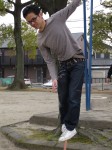 Back home, just about any park would do; decent trees and potential anchors aren’t hard to find. In Japan, things are a little tricker. The park layout is different, generally much more controlled, and so the trees will usually border the park itself, and aren’t really suitable as slackline anchors. We took a virtual drive around the neighborhood in google street view, looking for spots with some potential, and settled on an unnamed park a kilometer south of the office.
Back home, just about any park would do; decent trees and potential anchors aren’t hard to find. In Japan, things are a little tricker. The park layout is different, generally much more controlled, and so the trees will usually border the park itself, and aren’t really suitable as slackline anchors. We took a virtual drive around the neighborhood in google street view, looking for spots with some potential, and settled on an unnamed park a kilometer south of the office.
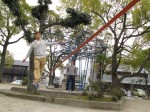 We found some suitable trees and set up the line, but they were too close together to get a decent amount of bounce, so I moved it to another pair of trees almost twice the distance apart. Much more suitable this time around, the only drawback was a rather uneven landing, halfway over a cement walkway. Oh well, beggars can’t be choosers. Just don’t eat it too badly!
We found some suitable trees and set up the line, but they were too close together to get a decent amount of bounce, so I moved it to another pair of trees almost twice the distance apart. Much more suitable this time around, the only drawback was a rather uneven landing, halfway over a cement walkway. Oh well, beggars can’t be choosers. Just don’t eat it too badly!
httpvh://www.youtube.com/watch?v=VORDByS8oMo
The guys soon learned that slackline isn’t quite as easy as it looks, but I assured them that with practice they would improve. They actually made remarkable progress, making several unaided steps by the time we tore the line down. We attracted quite a crowd, mostly kids who came to the park to play. A lot of them fearlessly jumped on the line, and had a blast.
httpvh://www.youtube.com/watch?v=Mz2QXdom79E
Kazuya and his friend Nobu brought some diabolo (chinese yo-yo) with them. Kazuya is apparently a pretty big name in the Japanese Diabolo community, and he’s got skills to prove it. both he and Nobu have over 10 years of experience playing diabolo, so when they got going the kids went wild. “Is this a dream?!” one of them asked, bewildered.
Never a dull moment, all afternoon I was either slacklining, yo-yoing, kicking around a soccer ball or hackey sack, trying my hand at diabolo, or climbing around on the playground equipment. I really hope I can make this a regular part of my schedule; it felt so good to run around and play for a change!
httpvh://www.youtube.com/watch?v=5OAoJdeeyB0


